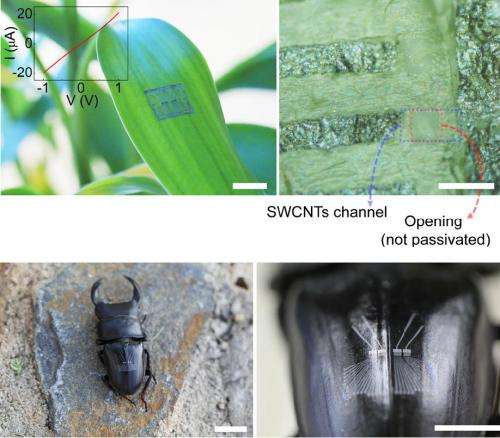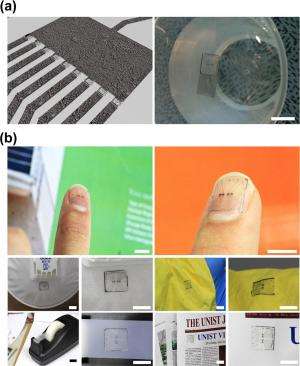May 6, 2014 feature
Flexible all-carbon electronics integrated onto plants, insects, and more

(Phys.org) —Carbon-based electronics are being widely explored due to their attractive electrical and mechanical properties, but synthesizing them in large quantities at low cost is still a challenge.
Now in a new study, researchers have developed a new method for synthesizing entire integrated all-carbon electronic devices, including transistors, electrodes, interconnects, and sensors, in a single step, greatly simplifying their formation. The inexpensive electronic devices can then be attached to a wide variety of surfaces, including plants, insects, paper, clothes, and human skin.
The researchers, Kyongsoo Lee, et al., at the Ulsan National Institute of Science and Technology (UNIST) in Ulsan Metropolitan City, South Korea, and the Korea Electrotechnology Research Institute in Changwon, South Korea, have published a paper on the new synthesis method in a recent issue of Nano Letters.
The new approach takes advantage of the unique atomic geometries of carbon to synthesize entire arrays of electronic devices, specifically carbon nanotube transistors, carbon nanotube sensors, and graphite electrodes.
"Our all-carbon devices (transistors and sensors) are composed of (i) carbon nanotubes (as channels) and (ii) graphite (as electrodes)," coauthor Jang-Ung Park, Assistant Professor at UNIST, told Phys.org. "The channel part requires semiconducting materials whose resistance can be sensitively controlled by external bias. The electrode part needs metallic materials whose resistance is very small with the negligible change by external bias."
As Park explained, the different properties of the nanotubes and graphite are due to their different bond structures.

"Both the carbon nanotubes and graphite are carbon," he said. "Depending on the bond structure of carbon, the carbon nanotubes can exhibit semiconducting properties and the graphite can show metallic properties. We designed multiple catalysts to synthesize the carbon nanotubes and graphite locally with the desired structures of electronic devices. In this way, the all-carbon devices can be synthesized."
The resulting devices demonstrate good performance, with the transistors operating with a high on-off ratio exceeding 103. To demonstrate the flexibility of the devices, the researchers transferred the sensors directly onto the curved surface of an optical fiber with a radius of 100 µm, where the sensors continued to operate normally.
The electronic devices can also be integrated onto various surfaces via van der Waals forces. For example, after wetting the transistors and sensors, the researchers showed that they can be attached to the leaf of a live bamboo plant and to the epidermis of a live stag beetle. The researchers also demonstrated that the sensors could be fitted onto the surfaces of a fingernail, a particulate mask, a protective arm sleeve, adhesive tape, and newspaper.
The widespread application of all-carbon electronics in outdoor environments could be useful for a variety of reasons. Here the researchers show that the sensors can detect very low levels of DMMP vapor, which is used for producing nerve agents such as soma and sarin. The sensors could also be used to monitor environmental conditions, including temperature, humidity, pollution, and infections. All this can be done without an on-board power source.
"We integrated antennas with our devices," Park said. "Thus, the wireless transportation of power and sensing signals was possible with no battery."
Due to their good adhesion to the nonplanar surfaces of biomaterials, the all-carbon electronics have the potential for use as bioimplantable devices, as well. The researchers plan to further explore the potential applications in the future.
"In this paper, we just demonstrated the detection of the nerve gas using the biocompatible devices," Park said. "As our future research, we will develop various sensing systems, including diabetes, pollutions and radioactivity, using the wearable electronic devices."
More information: Kyongsoo Lee, et al. "In-situ Synthesis of Carbon Nanotube-Graphite Electronic Devices and Their Integrations onto Surfaces of Live Plants and Insects." Nano Letters. DOI: 10.1021/nl500513n
Journal information: Nano Letters
© 2014 Phys.org





















